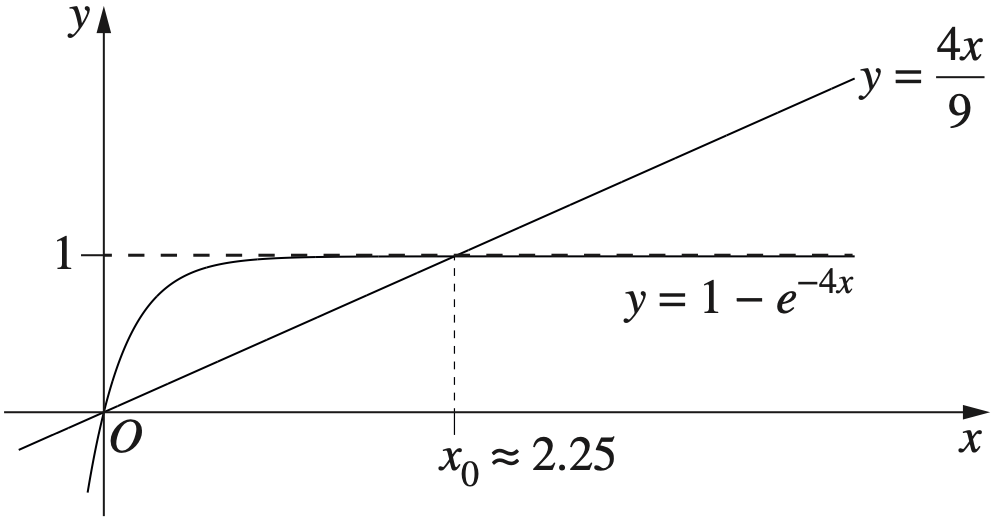A particle of mass 1 kg is projected from the origin with speed 40 m s\( ^{-1}\) at an angle 30° to the horizontal plane. --- 6 WORK AREA LINES (style=lined) --- The forces acting on the particle are gravity and air resistance. The air resistance is proportional to the velocity vector with a constant of proportionality 4 . Let the acceleration due to gravity be 10 m s \( ^{-2}\). The position vector of the particle, at time \(t\) seconds after the particle is projected, is \(\mathbf{r}(t)\) and the velocity vector is \(\mathbf{v}(t)\). --- 12 WORK AREA LINES (style=lined) --- --- 10 WORK AREA LINES (style=lined) --- --- 7 WORK AREA LINES (style=lined) ---

Mechanics, EXT2 M1 EQ-Bank 4
A torpedo with a mass of 80 kilograms has a propeller system that delivers a force of `F` on the torpedo, at maximum power. The water exerts a resistance on the torpedo proportional to the square of the torpedo's velocity `v`.
- Explain why `(dv)/(dt) = 1/80 (F - kv^2)`
where `k` is a positive constant. (1 mark)
--- 4 WORK AREA LINES (style=lined) ---
- If the torpedo increases its velocity from `text(10 ms)\ ^(−1)` to `text(20 ms)\ ^(−1)`, show that the distance it travels in this time, `d`, is given by
`d = 40/k log_e((F - 100k)/(F - 400k))` (3 marks)
--- 6 WORK AREA LINES (style=lined) ---
Mechanics, EXT2 M1 EQ-Bank 1
A canon ball of mass 9 kilograms is dropped from the top of a castle at a height of `h` metres above the ground.
The canon ball experiences a resistance force due to air resistance equivalent to `(v^2)/500`, where `v` is the speed of the canon ball in metres per second. Let `g=9.8\ text(ms)^-2` and the displacement, `x` metres at time `t` seconds, be measured in a downward direction.
- Show the equation of motion is given by
`ddotx = g - (v^2)/4500` (1 mark)
--- 4 WORK AREA LINES (style=lined) ---
- Show, by integrating using partial fractions, that
`v = 210((e^(7/75 t) - 1)/(e^(7/75 t) + 1))` (5 marks)
--- 12 WORK AREA LINES (style=lined) ---
- If the canon hits the ground after 4 seconds, calculate the height of the castle, to the nearest metre. (3 marks)
--- 8 WORK AREA LINES (style=lined) ---
Mechanics, EXT2 M1 2019 HSC 14b
A parachutist jumps from a plane, falls freely for a short time and then opens the parachute. Let t be the time in seconds after the parachute opens, `x(t)` be the distance in metres travelled after the parachute opens, and `v(t)` be the velocity of the parachutist in `text(ms)^(-1)`.
The acceleration of the parachutist after the parachute opens is given by
`ddot x = g - kv,`
where `g\ text(ms)^(-2)` is the acceleration due to gravity and `k` is a positive constant.
- With an open parachute the parachutist has a terminal velocity of `w\ text(ms)^(-1)`.
Show that `w = g/k`. (1 mark)
--- 2 WORK AREA LINES (style=lined) ---
At the time the parachute opens, the speed of descent is `1.6 w\ text(ms)^(-1)`.
- Show that it takes `1/k log_e 6` seconds to slow down to a speed of `1.1w\ text(ms)^(-1)`. (4 marks)
--- 10 WORK AREA LINES (style=lined) ---
- Let `D` be the distance the parachutist travels between opening the parachute and reaching the speed `1.1w\ text(ms)^(-1)`.
Show that `D = g/k^2 (1/2 + log_e 6)`. (3 marks)
--- 8 WORK AREA LINES (style=lined) ---
Mechanics, EXT2 M1 2012 HSC 13a
An object on the surface of a liquid is released at time `t = 0` and immediately sinks. Let `x` be its displacement in metres in a downward direction from the surface at time `t` seconds.
The equation of motion is given by
`(dv)/(dt) = 10 − (v^2)/40`,
where `v` is the velocity of the object.
- Show that `v = (20(e^t − 1))/(e^t + 1)`. (4 marks)
--- 10 WORK AREA LINES (style=lined) ---
- Use `(dv)/(dt) = v (dv)/(dx)` to show that
`x = 20\ log_e(400/(400 − v^2))` (2 marks)
--- 5 WORK AREA LINES (style=lined) ---
- How far does the object sink in the first 4 seconds? (2 marks)
--- 6 WORK AREA LINES (style=lined) ---